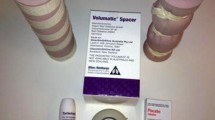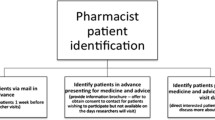Abstract
Objective To explore community pharmacists’ continuing education, counseling and communication practices, attitudes and barriers in relation to pediatric asthma management. Setting Community pharmacies in Michigan, United States. Methods Between July and September 2015 a convenience sample of community pharmacists was recruited from southeastern Michigan and asked to complete a structured, self-reported questionnaire. The questionnaire elucidated information on 4 general domains relating to pharmacists’ pediatric asthma management including: (1) guidelines and continuing education (CE); (2) counseling and medicines; (3) communication and self-management practices; (4) attitudes and barriers to practice. Regression analyses were conducted to determine predictors towards pharmacists’ confidence/frequency of use of communication/counseling strategies. Main outcome measure Confidence in counseling skills around asthma. Results 105 pharmacists completed the study questionnaire. Fifty-four percent of pharmacists reported participating in asthma related CE in the past year. Over 70% of pharmacists reported confidence in general communication skills, while a lower portion reported confidence in engaging in higher order self-management activities that involved tailoring the regimen (58%), decision-making (50%) and setting short-term (47%) and long-term goals (47%) with the patient and caregiver for managing asthma at home. Pharmacists who reported greater use of recommended communication/self-management strategies were more likely to report confidence in implementing these communication/self-management strategies when counseling caregivers and children with asthma [Beta (B) Estimate 0.58 SE (0.08), p < 0.001]. Female pharmacists [B Estimate −2.23 SE (1.01), p < 0.05] and those who reported beliefs around doctors being the sole provider of asthma education [B Estimate −1.00 SE (0.32), p < 0.01] were less likely to report confidence in implementing communication/self-management strategies. Conclusion A pharmacists’ confidence may influence their ability to implement recommended self-management counseling strategies. This study showed that community pharmacists are confident in general communication. However pharmacists are reporting lower confidence levels in counseling on higher order self-management strategies with patients. More appropriate and targeted continuing education programs for pharmacists around asthma self-management education are recommended.



Similar content being viewed by others
References
Prevention CfDCa. Summary health statistics for U.S. children: National Health Interview Survey 2012. http://www.cdc.gov/nchs/data/series/sr_10/sr10_258.pdf.
National Heart LaBI. Expert panel report 3: guidelines for the diagnosis and management of asthma. Bethesda: National Institutes of Health, Department of Health and Human Services; 2015. [May 07 2017]. https://www.nhlbi.nih.gov/files/docs/guidelines/asthgdln.pdf.
Prevention CfDCa. Trends in asthma prevalence, health care use, and mortality in the United States, 2001–2010 2012. [May 06 2017]. http://www.cdc.gov/nchs/data/databriefs/db94.pdf.
Santos LA, Oliveira MA, Faresin SM, Santoro IL, Fernandes AL. Direct costs of asthma in Brazil: a comparison between controlled and uncontrolled asthmatic patients. Braz J Med Biol Res. (Revista brasileira de pesquisas medicas e biologicas/Sociedade Brasileira de Biofisica [et al.]) 2007;40(7):943-8.
Masoli M, Fabian D, Holt S, Beasley R. Global initiative for asthma (GINA): Global burden of asthma 2015 [May 07 2017]. http://www.ginasthma.org/.
Arnrich B, Mayora O, Bardram J, Troster G. Pervasive healthcare: paving the way for a pervasive, user-centered and preventive healthcare model. Methods Inf Med. 2010;49(1):67–73.
Cabana MD, Chaffin DC, Jarlsberg LG, Thyne SM, Clark NM. Selective provision of asthma self-management tools to families. Pediatrics. 2008;121(4):e900–5.
Shipman SA, Sinsky CA. Expanding primary care capacity by reducing waste and improving the efficiency of care. Health Affairs (Project Hope). 2013;32(11):1990–7.
Arend J, Tsang-Quinn J, Levine C, Thomas D. The patient-centered medical home: history, components, and review of the evidence. Mt Sinai J. Med. 2012;79(4):433–50.
Armour C, Bosnic-Anticevich S, Brillant M, Burton D, Emmerton L, Krass I, et al. Pharmacy Asthma Care Program (PACP) improves outcomes for patients in the community. Thorax. 2007;62(6):496–502.
Armour CL, Reddel HK, LeMay KS, Saini B, Smith LD, Bosnic-Anticevich SZ, et al. Feasibility and effectiveness of an evidence-based asthma service in Australian community pharmacies: a pragmatic cluster randomized trial. J Asthma. 2013;50(3):302–9.
Basheti IA, Reddel HK, Armour CL, Bosnic-Anticevich SZ. Improved asthma outcomes with a simple inhaler technique intervention by community pharmacists. J Allergy Clin Immunol. 2007;119(6):1537–8.
Benavides S, Rodriguez JC, Maniscalco-Feichtl M. Pharmacist involvement in improving asthma outcomes in various healthcare settings: 1997 to present. Ann Pharmacother. 2009;43(1):85–97.
Bosnic-Anticevich SZ, Sinha H, So S, Reddel HK. Metered-dose inhaler technique: the effect of two educational interventions delivered in community pharmacy over time. J Asthma. 2010;47(3):251–6.
Mehuys E, Van Bortel L, De Bolle L, Van Tongelen I, Annemans L, Remon JP, et al. Effectiveness of pharmacist intervention for asthma control improvement. Eur Respir J. 2008;31(4):790–9.
Saini B, Krass I, Armour C. Development, implementation, and evaluation of a community pharmacy-based asthma care model. Ann Pharmacother. 2004;38(11):1954–60.
Um IS, Armour C, Krass I, Gill T, Chaar BB. Consumer perspectives about weight management services in a community pharmacy setting in NSW, Australia. Health Expect. 2014;17(4):579–92.
Elaro A, Shah S, Pomare LN, Armour CL, Bosnic-Anticevich SZ. PACE: Pharmacists use the power of communication in paediatric asthma. Int J Clin Pharm. 2014;36(5):976–85.
Lemay KS, Saini B, Bosnic-Anticevich S, Smith L, Stewart K, Emmerton L, et al. An exploration of clinical interventions provided by pharmacists within a complex asthma service. Pharm Pract. 2015;13(1):529.
Bunting BA, Cranor CW. The Asheville Project: long-term clinical, humanistic, and economic outcomes of a community-based medication therapy management program for asthma. J Am Pharm Assoc (2003). 2006;46(2):133–47.
Elaro A, Shah S, Armour CL, Bosnic-Anticevich SZ. A snapshot of pharmacist attitudes and behaviours surrounding the management of paediatric asthma. J Asthma. 2015.
Kritikos VS, Reddel HK, Bosnic-Anticevich SZ. Pharmacists’ perceptions of their role in asthma management and barriers to the provision of asthma services. Int J Pharm Pract. 2010;18(4):209–16.
Clark NM, Valerio MA. The role of behavioural theories in educational interventions for paediatric asthma. Paediatr Respir Rev. 2003;4(4):325–33.
Cabana MD, Slish KK, Evans D, Mellins RB, Brown RW, Lin X, et al. Impact of physician asthma care education on patient outcomes. Pediatrics. 2006;117(6):2149–57.
Clark NM, Cabana MD, Nan B, Gong ZM, Slish KK, Birk NA, et al. The clinician-patient partnership paradigm: outcomes associated with physician communication behavior. Clin Pediatr. 2008;47(1):49–57.
Shah S, Sawyer SM, Toelle BG, Mellis CM, Peat JK, Lagleva M, et al. Improving paediatric asthma outcomes in primary health care: a randomised controlled trial. Med J Aust. 2011;195(7):405–9.
Margolis KL, Asche SE, Bergdall AR, Dehmer SP, Groen SE, Kadrmas HM, et al. Effect of home blood pressure telemonitoring and pharmacist management on blood pressure control: a cluster randomized clinical trial. JAMA. 2013;310(1):46–56.
Weber CA, Ernst ME, Sezate GS, Zheng S, Carter BL. Pharmacist-physician comanagement of hypertension and reduction in 24-hour ambulatory blood pressures. Arch Intern Med. 2010;170(18):1634–9.
Santschi V, Chiolero A, Paradis G, Colosimo AL, Burnand B. Pharmacist interventions to improve cardiovascular disease risk factors in diabetes: a systematic review and meta-analysis of randomized controlled trials. Diabetes Care. 2012;35(12):2706–17.
Gerber BS, Rapacki L, Castillo A, Tilton J, Touchette DR, Mihailescu D, et al. Design of a trial to evaluate the impact of clinical pharmacists and community health promoters working with African-Americans and Latinos with diabetes. BMC Public Health. 2012;12:891.
Pape GA, Hunt JS, Butler KL, Siemienczuk J, LeBlanc BH, Gillanders W, et al. Team-based care approach to cholesterol management in diabetes mellitus: two-year cluster randomized controlled trial. Arch Intern Med. 2011;171(16):1480–6.
Grover C, Goel N, Chugh K, Gaur SN, Armour C, van Asperen PP, et al. Medication use in Indian children with asthma: the user’s perspective. Respirology (Carlton, Vic). 2013;18(5):807-13.
Grover C, Armour C, Asperen PPV, Moles R, Saini B. Medication use in children with asthma: not a child size problem. J Asthma. 2011;48(10):1085–103.
Capanoglu M, Dibek Misirlioglu E, Toyran M, Civelek E, Kocabas CN. Evaluation of inhaler technique, adherence to therapy and their effect on disease control among children with asthma using metered dose or dry powder inhalers. J Asthma. 2015;52(8):838–45.
Roydhouse JA, Shah S, Toelle BG, Sawyer SM, Mellis CM, Usherwood TP, et al. A snapshot of general practitioner attitudes, levels of confidence and self-reported paediatric asthma management practice. Aust J Prim Health. 2011;17(3):288–93.
Farland MZ, Byrd DC, McFarland MS, Thomas J, Franks AS, George CM, et al. Pharmacist-physician collaboration for diabetes care: the diabetes initiative program. Ann Pharmacother. 2013;47(6):781–9.
Furbish SML, Kroehl ME, Loeb DF, Lam HM, Lewis CL, Nelson J, et al. A pharmacist–physician collaboration to optimize benzodiazepine use for anxiety and sleep symptom control in primary care. J Pharm Pract. 2016.
Hirsch JD, Steers N, Adler DS, Kuo GM, Morello CM, Lang M, et al. Primary care–based, pharmacist–physician collaborative medication-therapy management of hypertension: a randomized, pragmatic trial. Clinical Therapeutics. 2014;36(9):1244–54.
Abdelnour M, Armour CL, Reddel HK, Bosnic-Anticevich SZ. Multidisciplinary asthma care teams: the role of the specialist pharmacist [online]. Aust Pharm. 2011;30(8):686–91.
Bradley CL, Luder HR, Beck AF, Bowen R, Heaton PC, Kahn RS, et al. Pediatric asthma medication therapy management through community pharmacy and primary care collaboration. J Am Pharm Assoc. 2016;56(4):455–60.
Acknowledgements
We are grateful to all of the community pharmacists who participated in this study.
Funding
This work was supported by the Askwith Fund for Asthma and Allergy Research, obtained through the Centre for Managing Chronic Diseases, University of Michigan, USA.
Author information
Authors and Affiliations
Corresponding author
Ethics declarations
Conflicts of interest
None.
Rights and permissions
About this article
Cite this article
Elaro, A., Bosnic-Anticevich, S., Kraus, K. et al. Pharmacists’ perspectives of the current status of pediatric asthma management in the U.S. community pharmacy setting. Int J Clin Pharm 39, 935–944 (2017). https://doi.org/10.1007/s11096-017-0471-1
Received:
Accepted:
Published:
Issue Date:
DOI: https://doi.org/10.1007/s11096-017-0471-1




